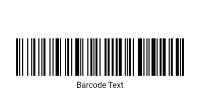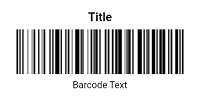The MSI-1010 barcode, an extension of the MSI (Modified Plessey) symbology, is designed to encode numeric data with a high degree of accuracy. It is part of the MSI barcode family, which is known for its simplicity and reliability in various applications requiring numeric data encoding.
The MSI-1010 barcode was developed by the MSI Data Corporation as an enhancement to the original MSI barcode. This variant includes additional features to improve data integrity and expand its applications. The "10" in MSI-1010 refers to its capability to include a 10-digit numeric code, providing a more comprehensive solution compared to the basic MSI-10.
Technical Specifications
MSI-1010 is engineered to encode 10 numeric digits and includes a modulo 10 check digit to ensure data accuracy. Each digit is represented by a distinct pattern of bars and spaces. The barcode starts with a specific start pattern and ends with a stop pattern, encapsulating the encoded data and a check digit for verification.
The barcode structure is as follows:
- Start Pattern: Indicates the beginning of the barcode sequence.
- Data Characters: Encodes 10 numeric digits, each represented by a unique pattern of bars and spaces.
- Checksum: A modulo 10 check digit is calculated and appended to ensure the accuracy of the encoded data.
- Stop Pattern: Signals the end of the barcode.
Checksum Calculation
The modulo 10 check digit for MSI-1010 is calculated to detect errors during scanning:
- Starting from the rightmost digit, double every second digit.
- Sum all digits, including those that were doubled. If doubling results in a two-digit number, add the digits of that result.
- Add the results from the previous step.
- Subtract this sum from the nearest equal or higher multiple of 10.
- The result is the check digit, which is then appended to the end of the barcode.
This method helps detect common errors and ensures that the barcode data is read accurately.
Advantages and Disadvantages
The MSI-1010 barcode offers several advantages, including a higher data capacity of 10 digits compared to simpler MSI variants. Its inclusion of a modulo 10 check digit enhances data integrity, making it suitable for applications where accuracy is crucial. The barcode's design ensures reliability and ease of use in various settings.
However, the MSI-1010 barcode is limited to numeric data, which can restrict its use in applications requiring alphanumeric characters or special symbols. Additionally, while it is more detailed than basic MSI-10, its larger size compared to some other barcode types may be a limitation in space-constrained environments.
MSI-1010 Applications
MSI-1010 is commonly used in various applications where numeric data encoding and verification are required:
- Inventory Management: Facilitates accurate tracking and management of inventory items. The check digit ensures that data errors are minimized, improving stock control processes.
- Library Systems: Helps in cataloging and tracking books and materials, making check-in and check-out processes more reliable.
- Retail: Used for pricing and product identification, ensuring that scanned data is accurate and reducing errors at checkout.
Comparison with Other Barcode Symbologies
MSI-1010 is similar to other numeric barcodes like UPC and Code 39 but offers specific benefits and limitations. Unlike UPC, which is limited to 12 digits and lacks a check digit, MSI-1010 provides a larger numeric range with built-in error detection. Compared to Code 39, which can encode both numbers and letters, MSI-1010 is limited to numeric data but offers higher reliability and accuracy for numeric encoding.
The MSI-1010 barcode provides a robust solution for encoding 10-digit numeric data with enhanced error detection capabilities. Its development as an extension of the MSI symbology has made it a valuable tool in inventory management, library systems, and retail applications. While its limitations to numeric data and larger size compared to some other barcodes may pose constraints, its accuracy and reliability make it a trusted choice for applications requiring precise numeric encoding and verification.


